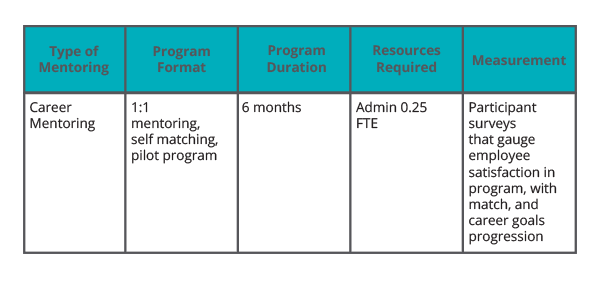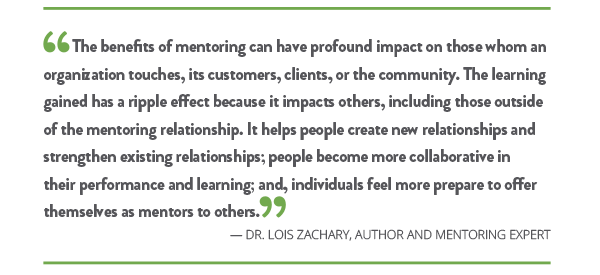Starting a mentoring initiative at your organization is exciting. You’ve researched the options for the best mentoring program format and put together a solid plan for your company. Perhaps you’ve even put together a return-on-investment (ROI) analysis. However, there’s always the final stage of the process before committing to launch—pitching career mentoring to stakeholders and securing their approval
How to Get Leadership Buy-In for Your Mentoring Program
Mentoring can help you tackle the most significant challenges facing your organization–but to get leadership support, you’ll need to provide the right details
Set Measurable Goals
Choose goals that are specific and time-bound and then build KPIs that accurately measure success.
For example, if you’re struggling to retain top-performing sales employees, you might look at retention rates, setting a target for 90% retention for three years. To show the program’s effectiveness, you would compare sellers who participate in the mentorship program with those who do not.
Explain How You Will Bring About Employee Engagement
How will you draw participants to ensure engagement with the mentoring program? Our customers have seen success with incentives like gift cards, completion certificates and spotlights in the company newsletter. Note that many of these incentives are free or low-cost and rely more on recognition than monetary consideration.
Detail The ROI of Mentoring Programs
Stakeholders will want to see that mentoring programs are worth the investment. Be ready to provide real numbers to back up your pitch.
Let’s say that you’re trying to show ROI for a mentoring program aimed at increasing retention. You might use an equation similar to the example in this ebook on the ROI of mentoring:
To keep it simple, say that retention increased by 5% out of 100 employees with an average salary of $100,000. Because the cost of replacing an employee is at least 1.5 times their salary, R would equal $750,000 (5 x $150,000).
Let’s also say that surveys showed that employee engagement increased by 10%, leading to an increase in sales of 25%, which in turn led to an annual revenue boost of $1,000,000. E would then equal $100,000 (.10 x $1,000,000).
If the program cost is $170,000, your ROI is 5. This means that you have a 5 to 1 return on investment.
mentor-mentee matching, including self-matching, admin matching, bulk matching and hybrid matching. Be ready to explain how your preferred model works best for your organization or group. For example, we’ve found that admin matching–in which admins match participants based on set criteria–is popular among leadership and academic mentoring programs.
Prepare Your Mentoring Proposal
Gaining leadership buy-in approval for your program is a crucial step: their support will ensure resources for the program, prioritize the initiative, and clear your program for launch. So before you have that meeting, make sure your pitch answers these four questions
What is a mentoring program?
Your audience might come to your pitch with varied understandings of what mentoring is and what your program is designed to do. They’ll have many questions. What format will it take? How much time will it require? Who will run it? How will feedback be gathered? Explain that mentoring is a smart way to harness internal resources and talent for cost-effective learning, engagement, and employee retention
Slideshare: Pitching Career Mentoring to Your Leadership
This is the perfect scenario for some corporate storytelling. Do what you can to tell the story. Depict the vision you have for the program. Outline the different roles of the administrators, mentors, and mentees. Look around for informal mentoring success stories that may have happened organically at your organization already. Highlight these and point out the benefits of scaling mentoring on a more formalized, company-wide scale
To back this up, create a project outline of the program, complete with goals, strategies, workflows, and recommended Key Performance Indicators (KPIs). If it’s a high-potential mentoring program, how will participants be identified? If it’s a diversity mentoring program, how do you plan to promote the program to targeted participants? Share how they’ll interact with each other, how their interactions will be tracked, and how program feedback will be captured for future learning
Here’s an example of how to create a snapshot of the program you want to build. Use this and expand on each category with your own story
Do we need a mentoring program?
If you have retention issues, leadership readiness challenges, knowledge transfer needs, or general employee morale concerns you want to address, then mentoring is a viable solution for your organization. In general, retention is 25% higher for employees who have engaged in company-sponsored mentoring1. Understand the stats or current trends that your organization is alarmed by or struggling with. Clarify the problem or problems your program is looking to solve. Use data and research to back up the intended impact. Are you supporting getting new hires to job competency? Are you providing a platform for employees to network and build their careers?
Oftentimes, it’s a matter of simply stopping employee attrition. It’s estimated that the cost to lose an employee can range from 100% to 300% of that employee’s salary2. Think about that multiplied over time. If you can, you might even calculate your attrition rate and potential costs to demonstrate to your leadership the negative effects of low employee engagement and satisfaction—two factors that can be improved through a corporate mentoring program
Remind your audience of the reasons this program is imperative. Employee initiatives need the right ecosystem to thrive, and this ecosystem is largely influenced by leadership. Discuss how and when you would like leadership to champion the program, how they can encourage participation, and why their involvement will have a direct impact
What are the benefits of a mentoring program?
It’s important to help leaders and stakeholders realize that mentoring is not just a “nice to have” program. Rather, mentoring is a program that generates tangible results that go beyond the immediate benefits of creating a tighter-knit culture or increasing employee satisfaction. The long-term benefits affect the company’s bottom line in real costs associated with employee retention and leadership readiness
Like any persuasive argument, your pitch should focus on the “so what” results that matter to your audience, and your audience members may vary in leadership levels and responsibilities. Do your research on who will be in the room, and come prepared to speak their language.
Tailor the benefits of a mentoring program to your audience members. The executive, for example, will be excited about the strategic emphasis on developing an agile workforce. The VP, in contrast, may be interested in the overall reduction of turnover costs that your program will create. The department head might in turn care about the improved performance of her staff. All these benefits are part of your mentoring program. Highlight the individual concerns in the room, while making sure to combine these into an overall benefits statement. The reality is mentoring has the power to touch everything in an organization. According to Dr. Lois Zachary, mentoring expert and author3:
How much does a mentoring program cost?
Eventually, the conversation will boil down to something on everyone’s mind: How much will it cost?
Cost discussions make many people uncomfortable, but it’s important to provide the purse-string holders with clear, realistic, and well-informed projections about program costs. Do your research about how much admin time your program will require, what kind of tools or software program expansion will require in order to manage the program, and what an operational budget should include to support program activities—training, events, or any other expenses. Remember, your program is going to have tangible, bottom-line benefits to the organization, so speak to costs as an investment rather than a loss
Next, be prepared to review the time expectations, both for program admins and participants. The beauty of mentoring is that it’s highly time efficient compared to most formal learning approaches. A participant’s time commitment depends on the type of mentoring program, but many career mentoring programs require one to three hours every month. This amount of time is a minimal distraction from daily duties, but still generates a rapid return on investment, culture and corporate learning
From the perspective of administrator time, costs can vary too. Smaller programs run manually can take up to 40% of a full-time position, averaged out between busy and slow periods. As programs grow beyond 50 participants, administrative load for matching, progress tracking, and measuring results can get time time-prohibitive. Acquiring mentoring program management software is often a preferred route in order to expand a program while keeping administrative costs and time commitments low. With features like automated matching, guided program workflows, built-in reporting, and metrics dashboards, software can be more cost-effective than adding additional staff to manually manage a program
Launch Your Career Mentoring Program with Help from Chronus
Chronus can help you demonstrate ROI to gain executive buy-in for your mentoring program. Show stakeholders the benefits of customizable matching technology, a guided experience for program participants and a flexible platform. Mentoring software lets you adapt your initiative to meet your organization’s needs, today and in the future
1Deloitte Research Brief, 2012.
2Inventive Talent Consulting, LLC, SHRM Webcast: Measuring and Mitigating the Cost of Employee Turnover, July, 2012
3Blog, Mentoring has a Multiplier Effect, Dr. Lois Zachary, President, Leadership Development Services, LLC.





